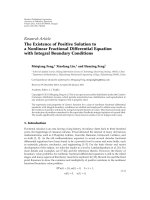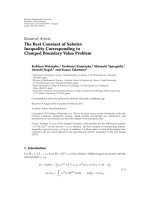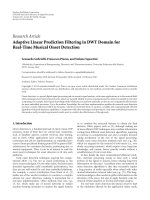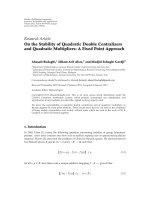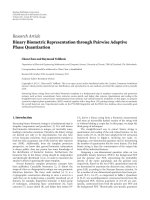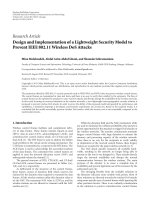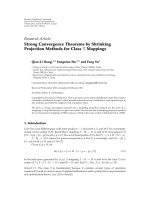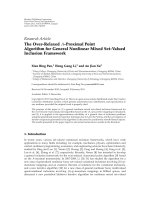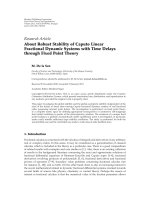Báo cáo hóa học: " Research Article Several Existence Theorems of Monotone Positive Solutions for Third-Order Multipoint Boundary Value Problems" ppt
Bạn đang xem bản rút gọn của tài liệu. Xem và tải ngay bản đầy đủ của tài liệu tại đây (499 KB, 9 trang )
Hindawi Publishing Corporation
Boundary Value Problems
Volume 2007, Article ID 17951, 9 pages
doi:10.1155/2007/17951
Research Article
Several Existence Theorems of Monotone Positive Solutions for
Third-Order Multipoint Boundary Value Problems
Weihua Jiang and Fachao Li
Received 3 May 2007; Accepted 12 September 2007
Recommended by Kanishka Perera
Using fixed point index theory, we obtain several sufficient conditions of existence of at
least one positive solution for third-order m-point boundary value problems.
Copyright © 2007 W. Jiang and F. Li. This is an open access article distributed under the
Creative Commons Attribution License, which permits unrestricted use, distribution,
and reproduction in any medium, provided the original work is properly cited.
1. Introduction
We are concerned with the existence of positive solutions for t he following third-order
multipoint boundary value problems:
u
(t)+h(t) f
t,u(t),u
(t)
=
0, a.e.t∈ [0,1],
u
(0) = u
(0) = 0, u(1) =
m−2
i=1
α
i
u
ξ
i
,
(1.1)
where 0 <ξ
1
<ξ
2
< ··· <ξ
m−2
< 1, α
i
> 0(i = 1,2, ,m − 2), 0 <
m−2
i
=1
α
i
< 1,h(t)maybe
singular at any point of [0,1] and f (t,u,v) satisfies Carath
´
eodory condition.
Third-order boundary value problem arises in boundary layer theory, the study of
draining and coating flows. By using the Leray-Schauder continuation theorem, the coin-
cidence degree theory, Guo-Krasnoselskii fixed point theorem, the Leray-Schauder non-
linear alternative theorem, and upper and lower solutions method, many authors have
studied certain boundary value problems for nonlinear third-order ordinary differential
equations. We refer the reader to [1–7] and references cited therein. By using the Leray-
Schauder nonlinear alternative theorem, Zhang et al. [1] studied the existence of at least
2 Boundary Value Problems
one nontrivial solution for the following third-order eigenvalue problems:
u
(t) = λf(t,u,u
), 0 <t<1,
u(0)
= u
(η) = u
(0) = 0,
(1.2)
where λ>0isaparameter,1/2
≤ η<1 is a constant, and f : [0,1] × R × R→R is continu-
ous.
By using Guo-Krasnoselskii fixed point theorem, Guo et al. [2] investigated the exis-
tence of at least one positive solution for the boundary value problems
u
(t)+a(t) f
u(t)
=
0, 0 <t<1,
u(0)
= u
(0) = 0, u
(1) = αu
(η),
(1.3)
where 0 <η<1, 1 <α<1/η,anda(t)and f (u) are continuous.
The aim of this paper is to establish some results on existence of monotone positive
solutions for problems (1.1). To do this, we give at first the associated Green function
and its properties. Then we obtain several theorems of existence of monotone p ositive
solutions by using the fixed point index theory. Our results differ from those of [1–3]and
extend the results of [1–3]. Particularly, we do not need any continuous assumption on
the nonlinear term, which is essential for the technique used in [1–3].
We always suppose the following conditions are satisfied:
(C
1
) α
i
> 0(i = 1,2, , m − 2),
m−2
i
=1
α
i
< 1, 1 = ξ
0
<ξ
1
<ξ
2
< ··· <ξ
m−1
= 1;
(C
2
) h(t) ∈ L
1
[0,1], h(t) ≥ 0, a.e.t∈ [0,1],
ξ
m−2
0
h(t)dt > 0;
(C
3
) f : [0,1] × [0,∞) × (−∞,0]→[0,∞) satisfies Carath
´
eodory conditions, that is,
f (
·,u,v) is measur a ble for each fixed u ∈ [0,∞),v ∈ (−∞,0] and f (t, ·,·)iscon-
tinuous for a.e. t
∈ [0,1];
(C
4
)foranyr,r
> 0, there exists Φ(t) ∈ L
∞
[0,1] such that f (t,u,v) ≤ Φ(t), where
(u,v)
∈ [0,r] × [−r
,0],a.e.t∈ [0,1].
2. Preliminary lemmas
Lemma 2.1 (Krein-Rutman [8]). Let K be a reproducing cone in a real Banach space X and
let L : X
→X be a compact linear operator with L(K) ⊆ K. r(L) is the spectral radius of L.If
r(L) > 0,thenthereexistsϕ
1
∈ K \{0} such that Lϕ
1
= r(L)ϕ
1
.
Lemma 2.2 [9]. Let X be a Banach space, P aconeinX, and Ω(P) a bounded open subset in
P.SupposethatA :
Ω(P)→P is a completely continuous operator. Then the following results
hold.
(1) If there exists u
0
∈ P \{0} such that u/=Au +λu
0
, for all u(t) ∈ ∂Ω(P), λ ≥ 0, then
the fixed point index i(A,Ω(P),P)
= 0.
(2) If 0
∈ Ω(P) and Au /=λu,∀u(t) ∈ ∂Ω(P), λ ≥ 1,thenthefixedpointindexi(A,
Ω(P),P)
= 1.
We can easily get the following lemmas.
W. Jiang and F. Li 3
Lemma 2.3. Suppose
m−2
i
=1
α
i
/= 1.Ify(t) ∈ L
1
[0,1], then the problem
u
(t)+y(t) = 0, a.e.t∈ [0,1],
u
(0) = u
(0) = 0, u(1) =
m−2
i=1
α
i
u
ξ
i
(2.1)
has a unique solut ion:
u(t)
=−
1
2
t
0
(t − s)
2
y(s)ds+
1
2
1 −
m−2
i
=1
α
i
1
0
(1 − s)
2
y(s)ds
−
1
2
1 −
m−2
i
=1
α
i
m−2
i=1
α
i
ξ
i
0
ξ
i
− s
2
y(s)ds.
(2.2)
Lemma 2.4. Suppose 0 <
m−2
i
=1
α
i
< 1, y(t) ∈ L
1
[0,1], y(t) ≥ 0.Thentheuniquesolution
of (2.1)satisfiesu(t)
≥ 0, u
(t) ≤ 0.
Lemma 2.5. Suppose 0 <
m−2
i
=1
α
i
< 1. The Green function for the boundary value problem
−u
(t) = 0, 0 <t<1,
u
(0) = u
(0) = 0, u(1) =
m−2
i=1
α
i
u
ξ
i
(2.3)
is given by
G(t,s)
=
⎧
⎪
⎪
⎪
⎪
⎪
⎪
⎪
⎪
⎪
⎪
⎪
⎪
⎪
⎪
⎪
⎪
⎨
⎪
⎪
⎪
⎪
⎪
⎪
⎪
⎪
⎪
⎪
⎪
⎪
⎪
⎪
⎪
⎪
⎩
(1 − s)
2
−
m−2
j
=ω
α
j
ξ
j
− s
2
−
1 −
m−2
i
=1
α
i
(t − s)
2
2
1 −
m−2
i
=1
α
i
,
0
≤ t ≤ 1, ξ
ω−1
≤ s ≤ min{ξ
ω
,t}, ω = 1,2, , m − 1,
(1
− s)
2
−
m−2
j
=ω
α
j
ξ
j
− s
2
2(1 −
m−2
i
=1
α
i
,
0
≤ t ≤ 1, max
ξ
ω−1
,t
≤
s ≤ ξ
ω
, ω = 1,2, ,m − 1.
(2.4)
Obviously, G(t,s) is nonnegative and continuous in [0,1]
× [0,1],and
G(t,s) ≥
1 − ξ
m−2
2
2
1 −
m−2
i
=1
α
i
, t,s ∈
0,ξ
m−2
. (2.5)
3. Main results
Let X
= C
1
[0,1] with norm x=max
t∈[0,1]
|x(t)| +max
t∈[0,1]
|x
(t)|. Clearly, (X,·)is
a Banach space. Take P
={u ∈ X | u ≥ 0, u
≤ 0}, P
r
={u ∈ P |u <r}, r>0. Obvi-
ously, P is a cone in X and P
r
is an open bounded subset in P.
Lemma 3.1. P is a reproducing cone in X.
4 Boundary Value Problems
Proof. Let x
∈ X,thenx
∈ C[0,1] and x
= x
+
− x
−
,wherex
+
= max{x
(t),0.},x
−
=
max{−x
(t),0.}. Obviously, x
+
,x
−
∈ C[0,1] and x
+
≥ 0, x
−
≥ 0. Integrating x
= x
+
− x
−
from t to 1, we get
x(t)
=−
1
t
x
+
(s)ds+
1
t
x
−
(s)ds+ x(1). (3.1)
If x(1)
≥ 0, let x
1
(t) =
1
t
x
−
(s)ds + x(1), x
2
(t) =
1
t
x
+
(s)ds,thenx
1
,x
2
∈ P,andx = x
1
−
x
2
. If x(1) < 0, let x
1
(t) =
1
t
x
−
(s)ds, x
2
(t) =
1
t
x
+
(s)ds − x(1), then x
1
,x
2
∈ P,andx =
x
1
− x
2
. The proof is completed.
Define operators A : P→X, L : X→X as follows:
Au
=
1
0
G(t,s)h(s) f
s,u(s),u
(s)
ds,
Lu
=
1
0
G(t,s)h(s)
u(s) − u
(s)
ds.
(3.2)
By Lemma 2.3,wegetthatifu(t)
∈ P \{0} is a fixed point of A,thenu(t)isamono-
tone positive solution of (1.1). Assume (C
1
)–(C
4
) hold, then we can easily get that A :
P
→P and L : P→P are completely continuous by the absolute continuity of integral,
Ascoli-Arzela theorem, Lemmas 2.3, 2.4,and2.5.
Lemma 3.2. Suppose (C
1
)–(C
2
) hold; then r(L) > 0.
Proof. Take u(t)
≡ 1. For t ∈ [0,ξ
m−2
]weget
Lu(t)
=
1
0
G(t,s)h(s)ds ≥
ξ
m−2
0
G(t,s)h(s)ds ≥
1 − ξ
m−2
2
2
1 −
m−2
i
=1
α
i
ξ
m−2
0
h(s)ds := l>0.
L
2
u(t) ≥
1
0
G(t,s)h(s)Lu(s)ds ≥
ξ
m−2
0
G(t,s)h(s)Lu(s)ds ≥ l
2
.
(3.3)
By mathematical induction, it can b e proved that
L
n
u(t) ≥ l
n
, ∀t ∈
0,ξ
m−2
. (3.4)
Hence
L
n
1/n
≥ l, r(L) = lim
n→∞
L
n
1/n
≥ l>0. (3.5)
The proof is completed.
By Lemma 2.1,wegetthatL has an eigenfunction ϕ ∈ P \{0} corresponding to r(L).
Let μ
= 1/r(L).
W. Jiang and F. Li 5
For convenience, we make the following definitions:
f (u,v) = sup
t∈[0,1]\E
f (t,u,v), f (u,v) = inf
t∈[0,1]\E
f (t,u,v),
f
c,0
= max
liminf
u→0
+
inf
v∈[−c,0]
f (u,v)
u − v
, liminf
v→0
−
inf
u∈[0,c]
f (u,v)
u − v
,
f
∞
= max
limsup
u→∞
sup
v∈R
−
f (u,v)
u − v
,limsup
v→−∞
sup
u∈R
+
f (u,v)
u − v
,
(3.6)
where c>0, R
+
= [0,∞), R
−
= (−∞,0], E ⊂ [0,1] with null Lebesgue measure.
Lemma 3.3. Suppose (C
1
)–(C
4
) hold. In addition, suppose 0 ≤ f
∞
<μ, then there exists
r
0
> 0 such that
i
A,P
r
,P
=
1 for each r>r
0
. (3.7)
Proof. Let ε>0 be small enough such that f
∞
<μ− ε. Then there exists r
1
> 0suchthat
f (t,u,v)
≤ (μ − ε)(u − v)foru>r
1
,orv<−r
1
,a.e.t∈ [0,1]. (3.8)
By (C
4
), there exists Φ ∈ L
∞
[0,1] such that
f (t,u,v)
≤ Φ(t)foru,v ∈
0,r
1
×
−
r
1
,0
,a.e.t∈ [0,1]. (3.9)
Sowegetthatforallu
∈ R
+
,v ∈ R
−
,a.e.t∈ [0,1],
f (t,u,v)
≤ (μ − ε)(u − v)+Φ(t). (3.10)
Since 1/μ is the spectrum radius of L,(I/(μ
− ε) − L)
−1
exists. Let
C =
1
0
G(t,s)h(s)Φ(s)ds
, r
0
=
1
μ − ε
I
− L
−1
C
μ − ε
e
1−t
. (3.11)
We will show that for r>r
0
,
Au /
= λu for each u ∈ ∂P
r
, λ ≥ 1. (3.12)
In fact, if not, there exist u
0
∈ ∂P
r
, λ
0
≥ 1suchthatAu
0
= λ
0
u
0
. This, together with (3.10)
and Lemma 2.4, implies
u
0
≤ λ
0
u
0
= Au
0
≤ (μ − ε)Lu
0
+ C,
u
0
≥ λ
0
u
0
=
Au
0
≥ (μ − ε)
Lu
0
− C.
(3.13)
Thus,
1
μ − ε
I
− L
u
0
(t) ≤
C
μ − ε
e
1−t
,
1
μ − ε
I
− L
u
0
(t)
≥
C
μ − ε
e
1−t
. (3.14)
6 Boundary Value Problems
So, we get
C
μ − ε
e
1−t
−
1
μ − ε
I
− L
u
0
(t) ∈ P. (3.15)
It follows from ((1/(μ
− ε))I − L)
−1
=
∞
n=0
(μ − ε)
n+1
L
n
and L(P) ⊂ P that
u
0
(t) ≤
1
μ − ε
I
− L
−1
C
μ − ε
e
1−t
, u
0
(t) ≥
1
μ − ε
I
− L
−1
C
μ − ε
e
1−t
. (3.16)
Therefore, we have
u
0
≤r
0
<r; this is a contradiction.
By (2) of Lemma 2.2,wegetthati(A,P
r
,P) = 1, for each r>r
0
.Theproofiscompleted.
Lemma 3.4. Suppose (C
1
)–(C
4
) hold and there exists c>0 satisfying μ< f
c,0
≤∞, then there
exists 0 <ρ
0
≤ c such that for ρ ∈ (0,ρ
0
], if u/=Au for u ∈ ∂P
ρ
, then i(A,P
ρ
,P) = 0.
Proof. Let ε>0 be small enough such that f
c,0
>μ+ ε. Then there exists 0 <ρ
0
≤ c such
that
f (t,u,v)
≥ (μ +ε)(u − v)for0≤ u ≤ ρ
0
, − ρ
0
≤ v ≤ 0, a.e.t∈ [0,1]. (3.17)
Let ρ
∈ (0,ρ
0
]. Considering of (1) of Lemma 2.2, we need only to prove that
u/
=Au +λϕ for each u ∈ ∂P
ρ
, λ>0, (3.18)
where ϕ
∈ P \{0} is the eigenfunction of L corresponding to r(L).
In fact, if not, there exist u
0
∈ ∂P
ρ
, λ
0
> 0suchthatu
0
= Au
0
+ λ
0
ϕ. This implies u
0
≥
λ
0
ϕ and u
0
≤ λ
0
ϕ
.Let
λ
∗
= sup
λ | u
0
≥ λϕ, u
0
≤ λϕ
. (3.19)
Clearly,
∞ >λ
∗
≥ λ
0
> 0, u
0
≥ λ
∗
ϕ, u
0
≤ λ
∗
ϕ
. Therefore, we get u
0
− λ
∗
ϕ ∈ P.Itfollows
from L(P)
⊂ P that
μLu
0
≥ λ
∗
μLϕ = λ
∗
ϕ, μ
Lu
0
≤ λ
∗
μ(Lϕ)
= λ
∗
(ϕ)
. (3.20)
By (3.17) and Lemma 2.4,weget
Au
0
≥ (μ +ε)Lu
0
,
Au
0
≤ (μ +ε)
Lu
0
. (3.21)
So, we have
u
0
= Au
0
+ λ
0
ϕ ≥ (μ + ε)Lu
0
+ λ
0
ϕ ≥
λ
∗
+ λ
0
ϕ,
u
0
=
Au
0
+ λ
0
(ϕ)
≤ (μ +ε)
Lu
0
+ λ
0
(ϕ)
≤
λ
∗
+ λ
0
(ϕ)
,
(3.22)
which contradict the definition of λ
∗
. So, Lemma 3.4 holds.
In the following theorems, we always suppose (C
1
)–(C
4
)hold.
W. Jiang and F. Li 7
Theorem 3.5. Assume that there exists c>0 such that μ< f
c,0
≤∞, and 0 ≤ f
∞
<μ, then
(1.1)haveatleastonepositivesolution.
Proof. It follows from 0
≤ f
∞
<μand Lemma 3.3 that there exists r>0suchthati(A,
P
r
,P) = 1. By μ< f
c,0
≤∞and Lemma 3.4, we get that there exists 0 <ρ<min{r,c} such
that either there exists u
∈ ∂P
ρ
satisfying u = Au or i(A,P
ρ
,P) = 0. In the second case, A
hasafixedpointu
∈ P with ρ<u <r bythepropertiesofindex.Theproofiscom-
pleted.
Theorem 3.6. Assume that the following assumptions are satis fied.
(H
1
) There exists c>0 such that μ< f
c,0
≤∞.
(H
2
) There exists ρ
1
> 0 such that
f (t,u,v)
≤ m
0
ρ
1
for u ∈
0,ρ
1
, v ∈
− ρ
1
,0
, a.e.t∈ [0,1], (3.23)
where m
0
= 1/
1
0
G(t,s)h(s)ds.
Then (1.1)haveatleastonepositivesolution.
Proof. For u
∈ ∂P
ρ
1
,by(3.23) and Lemma 2.4,weobtain
Au= max
t∈[0,1]
Au +max
t∈[0,1]
(−Au)
= max
t∈[0,1]
1
0
G(t,s)h(s) f
s,u(s),u
(s)
ds+max
t∈[0,1]
−
1
0
G(t,s)h(s) f
s,u(s),u
(s)
ds
≤ m
0
ρ
1
max
t∈[0,1]
1
0
G(t,s)h(s)ds+max
t∈[0,1]
−
1
0
G(t,s)h(s)ds
≤
ρ
1
.
(3.24)
This implies Au /
=λu for each u ∈ ∂P
ρ
1
,λ>1. If Au /= u for u ∈ ∂P
ρ
1
, by (2) of Lemma 2.2
we get i(A,P
ρ
1
,P) = 1.
It follows from μ< f
c,0
≤∞and Lemma 3.4 that there exists 0 <ρ<min{c,ρ
1
} such
that either there exists u
∈ ∂P
ρ
satisfying u = Au or i(A,P
ρ
,P) = 0.
Suppose Au /
=u for u ∈ ∂P
ρ
1
∪ ∂P
ρ
(otherwise the proof is completed), by the proper-
ties of index we get that A has a fixed point u
∈ P satisfying ρ<u <ρ
1
.SoTheorem3.6
holds.
Theorem 3.7. Assume that the following assumptions are satis fied.
(H
3
)0≤ f
∞
<μ.
(H
4
) There exists ρ
2
> 0 such that
f (t,u,v)
≥ M
0
ρ
2
for u ∈ [0,ρ
2
], v ∈ [−ρ
2
,0], a.e.t∈ [0,1], (3.25)
where M
0
= 1/min
t∈[0,ξ
m−2
]
[
1
0
G(t,s)h(s)ds− (
1
0
G(t,s)h(s)ds)
].
Then (1.1)haveatleastonepositivesolution.
8 Boundary Value Problems
Proof. For u
∈ ∂P
ρ
2
, t ∈ [0,ξ
m−2
], by (3.25) and Lemma 2.4 we get
Au
− (Au)
=
1
0
G(t,s)h(s) f
s,u(s),u
(s)
ds−
1
0
G(t,s)h(s) f
s,u(s),u
(s)
ds
≥ M
0
ρ
2
1
0
G(t,s)h(s)ds−
1
0
G(t,s)h(s)ds
≥
ρ
2
.
(3.26)
This implies u/
=Au + λϕ,for u ∈ ∂P
ρ
2
,λ>0, where ϕ ∈ P \{0} is the eigenfunction of L
corresponding to r(L). Suppose u/
=Au,for u ∈ ∂P
ρ
2
(otherwise, the proof is completed),
by (1) of Lemma 2.2 we get i(A, P
ρ
2
,P) = 0.
By 0
≤ f
∞
<μand Lemma 3.3, we get that there exists r>ρ
2
such that i(A,P
r
,P) = 1.
By the properties of index, we get that A has a fixed point u satisfying ρ
2
< u <r.The
proof is completed.
Theorem 3.8. Assume that there exist ρ
1
, ρ
2
satisfying 0 <ρ
2
<ρ
1
m
0
/M
0
such that (3.23)
and (3.25)hold,wherem
0
, M
0
are the same as in Theorems 3.6 and 3.7.Then(1.1)haveat
least one positive solution.
Proof. By the proving process of Theorems 3.6 and 3.7, we can easily get this result.
Acknowledgments
The project is supported by Chinese National Natural Science Foundation under Grant
no. (70671034), the Natural Science Foundation of Hebei Province (A2006000298), and
the Doctoral Program Foundation of Hebei Province (B2004204).
References
[1] X. Zhang , L. Liu, and C. Wu, “Nontrivial solution of third-order nonlinear eigenvalue prob-
lems,” Applied Mathematics and Computation, vol. 176, no. 2, pp. 714–721, 2006.
[2] L J. Guo, J P. Sun, and Y H. Zhao, “Existence of positive solutions for nonlinear third-order
three-point boundary value problems ,” to appear in Nonlinear Analysis: Theory, Methods &
Applications.
[3] Z. Du, W. Ge, and X . Lin, “Existence of solutions for a class of third-order nonlinear boundary
value problems,” Journal of Mathematical Analysis and Applications, vol. 294, no. 1, pp. 104–112,
2004.
[4] A. Cabada, F. Minh
´
os, and A. I. Santos, “Solvability for a third order discontinuous fully equa-
tion with nonlinear functional boundary conditions,” Journal of Mathematical Analysis and Ap-
plications, vol. 322, no. 2, pp. 735–748, 2006.
[5] D. Jiang and R. P. Agarwal, “A uniqueness and existence theorem for a singular third-order
boundary value problem on [0,
∞),” Applied Mathematics Letters, vol. 15, no. 4, pp. 445–451,
2002.
[6] D. Anderson and R. I. Avery, “Multiple positive solutions to a third-order discrete focal bound-
ary value problem,” Computers & Mathematics with Applications, vol. 42, no. 3–5, pp. 333–340,
2001.
[7] J. Wang, W. Gao, and Z. Zhang , “Singular nonlinear boundary value problems arising in bound-
ary layer theory,” Journal of Mathematical Analysis and Applications, vol. 233, no. 1, pp. 246–256,
1999.
W. Jiang and F. Li 9
[8] V. Paatashvili and S. Samko, “Boundary value problems for analytic functions in the class of
Cauchy-type integrals with density in L
P(·)
(Γ),” Boundary Value Problem, vol. 2005, no. 1, pp.
43–71, 2005.
[9] R. P. Agarwal and I. Kiguradze, “Two-point boundary value problems for higher-order linear
differential equations with strong singularities,” Boundary Value Problems, vol. 2006, Article
ID 83910, 32 pages, 2006.
Weihua Jiang: College of Sciences, Hebei University of Science and Technology, Shijiazhuang,
Hebei 050018, China; College of Mathematics and Science of Information, Hebei Normal University,
Shijiazhuang, Hebei 050016, China
Email address:
Fachao Li: College of Sciences, Hebei University of Science and Technology, Shijiazhuang,
Hebei 050018, China
Email address:
